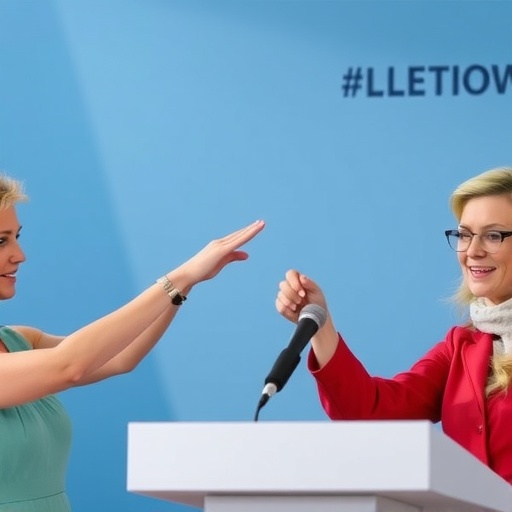Recent research into the dynamics of UK General Elections from 2015 to 2019 reveals compelling evidence of persistent gender disparities in political engagement and media representation. Female candidates, despite often exerting greater effort and experience, consistently face obstacles in gaining equal media recognition and social media traction compared to their male counterparts. This underrepresentation not only affects their visibility but also translates into tangible electoral disadvantages, underscoring an enduring gender penalty within British politics.
A comprehensive study published in the newly released book “Media and the British General Elections of 2015–2019” meticulously examines the multifaceted interactions between traditional media, social media platforms, and electoral processes. The research dissects how coverage by newspapers — predominantly from conservative-leaning outlets — influences television news narratives, ultimately shaping public perceptions and voter behavior. This interplay accentuates the growing presidentialisation of British elections, where media focus gravitates more towards party leaders than party policies themselves.
The data underpinning this research emerges from the British Election Longitudinal News Study (BELNS), a unique and robust dataset enabling scholars to quantify not only the volume of media attention but also its tone and thematic salience. By employing advanced sentiment analysis and network modeling techniques, the researchers illuminate the mechanisms through which media gatekeeping affects political discourse and candidate success. Traditional news outlets retain substantial authority in agenda-setting, dictating which issues dominate electoral conversation even as social media offers a parallel, decentralized information flow.
One of the most striking findings pertains to gendered patterns in social media engagement. A detailed analysis of over 1,500 candidates in the 2019 election, encompassing 920 men and 587 women, reveals that female candidates outpaced their male counterparts in tweet volume. However, this increased communicative output paradoxically garnered fewer retweets, pointing to systemic disparities in audience amplification. Such disparities suggest ingrained biases within digital political communication networks, where male candidates benefit from disproportionate online visibility.
Moreover, media coverage of female candidates was less effective in fostering electoral success. Whereas male candidates seemingly convert media attention more readily into votes, women are compelled to invest significantly more resources, skill development, and campaign effort to achieve equivalent results. This phenomenon may stem from a combination of voter biases and differential media framing, which, despite its challenges, female politicians nevertheless navigate to secure electoral victories.
The study also probes the tone of media coverage across constituencies classified as safe or competitive. Interestingly, the volume of attention did not markedly differ between safe and marginal seats for either gender, debunking the notion that safe seats are systematically neglected by the press. However, subtle gender differences in sentiment emerged, with men tending to receive more favorable coverage in safe constituencies, while women gained relatively more positive tone in contested districts. This nuanced dynamic suggests that the competitive intensity of elections influences the media’s evaluative stance towards candidates in complex ways.
Further dissecting the link between media tone and electoral context, researchers identified a correlation between closely fought elections and more positive media sentiment. Such optimistic coverage surrounding competitive races may invigorate voter engagement and suggests that media framing can modulate the perceived stakes of an election. These findings contribute to a deeper understanding of how journalistic practices shape not only candidate fortunes but also broader political participation.
The evolving landscape of political communication is underscored by the differentiation between traditional media’s agenda-setting powers and social media’s role in message dissemination. While newspapers and broadcasters continue to dominate which issues gain prominence, social media platforms facilitate rapid, peer-to-peer circulation of political content. However, the impact of social media on diminishing the influence of partisan press remains ambiguous and temporally constrained, as evidenced by its limited effect solely in the 2017 election and only with respect to public affect towards specific leaders.
The intersection of media tone with voters’ political engagement reveals further complexities. Negative coverage of female and ethnic minority candidates was paradoxically linked to heightened political discussion, increased interest, and greater intention to participate among certain segments of the electorate. This counterintuitive effect suggests that adverse media portrayals may stimulate political activism, possibly by mobilizing solidarity or awareness among sympathetic audiences.
Collectively, these insights illuminate entrenched gender biases permeating both the traditional and new media ecosystems involved in British electoral politics. Female candidates face a double bind: they must surmount greater campaign challenges and simultaneously counter disproportionately negative or muted media representation. Yet, their ability to achieve electoral success under these conditions testifies to resilience and underscores the urgent necessity of addressing systemic inequities within political communication.
This research advances the scholarly discourse by blending sophisticated data analytics with empirical evaluation of multiple electoral cycles, revealing evolving patterns yet persistent obstacles in UK politics. It underscores the critical importance of media literacy, equitable coverage, and digital platform reforms to foster a more inclusive democratic landscape, where all candidates can compete fairly regardless of gender.
As British elections continue to evolve under the influence of social media proliferation and media consolidation, understanding the nuanced relationships among candidate characteristics, media function, and voter behavior becomes essential. This body of research provides not only diagnostic clarity but also a foundation for future initiatives aimed at mitigating gender biases and enhancing the democratic representativeness of electoral contests in Britain.
Subject of Research:
Media effects and gender disparities in UK General Elections from 2015 to 2019.
Article Title:
Media and the British General Elections of 2015–2019.
News Publication Date:
Not specified in the content.
Web References:
https://edinburghuniversitypress.com/book-media-and-the-british-general-elections-of-2015-2019.html
References:
Based on research by Daniel Stevens, Susan Banducci, Laszlo Horvath, Ekaterina Kolpinskaya, Kiran Arabaghatta Basavaraj, Patrick English, Hannah Bunting, Charlotte James, Iulia Cioroianu, Amanda Haraldsson.
Keywords:
Political science; Government; Political process; Sociopolitical systems; Democracy; Elections; Media influence; Gender bias; Social media; Electoral behavior; British politics; Media coverage.




